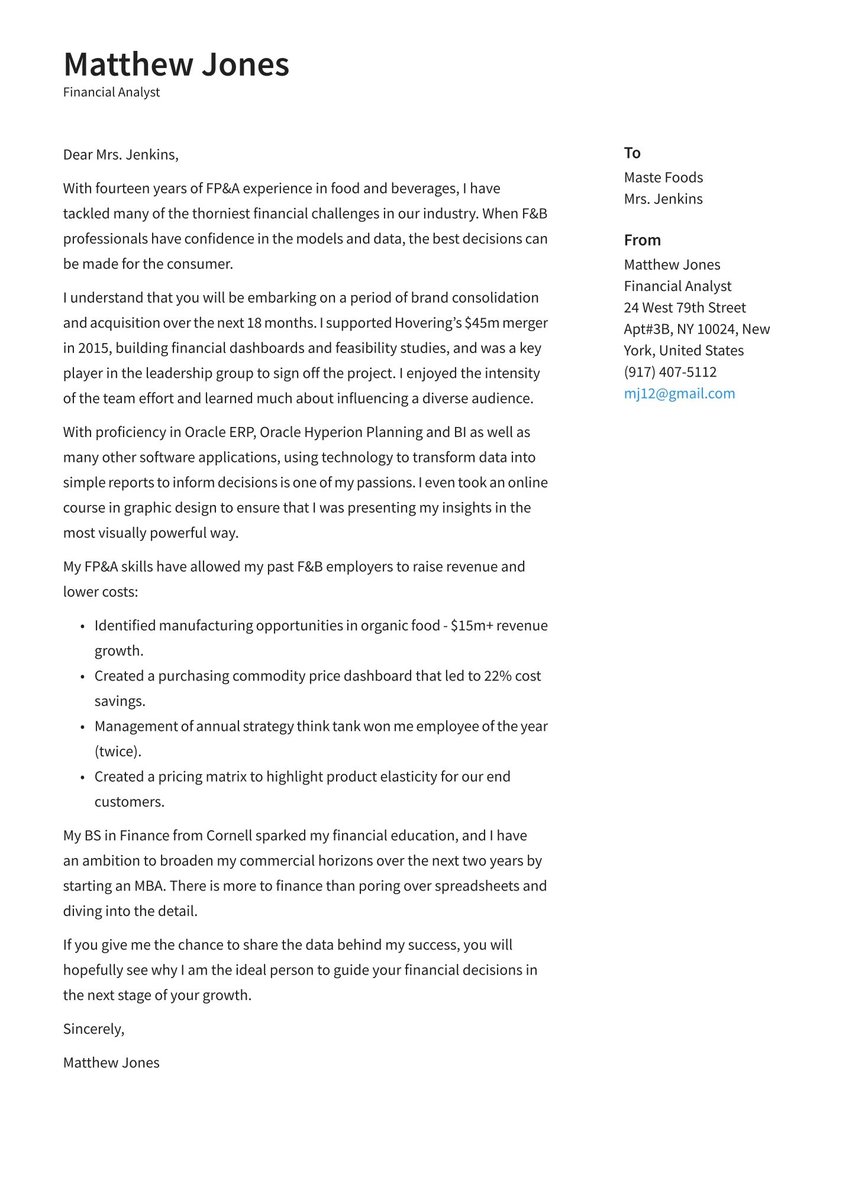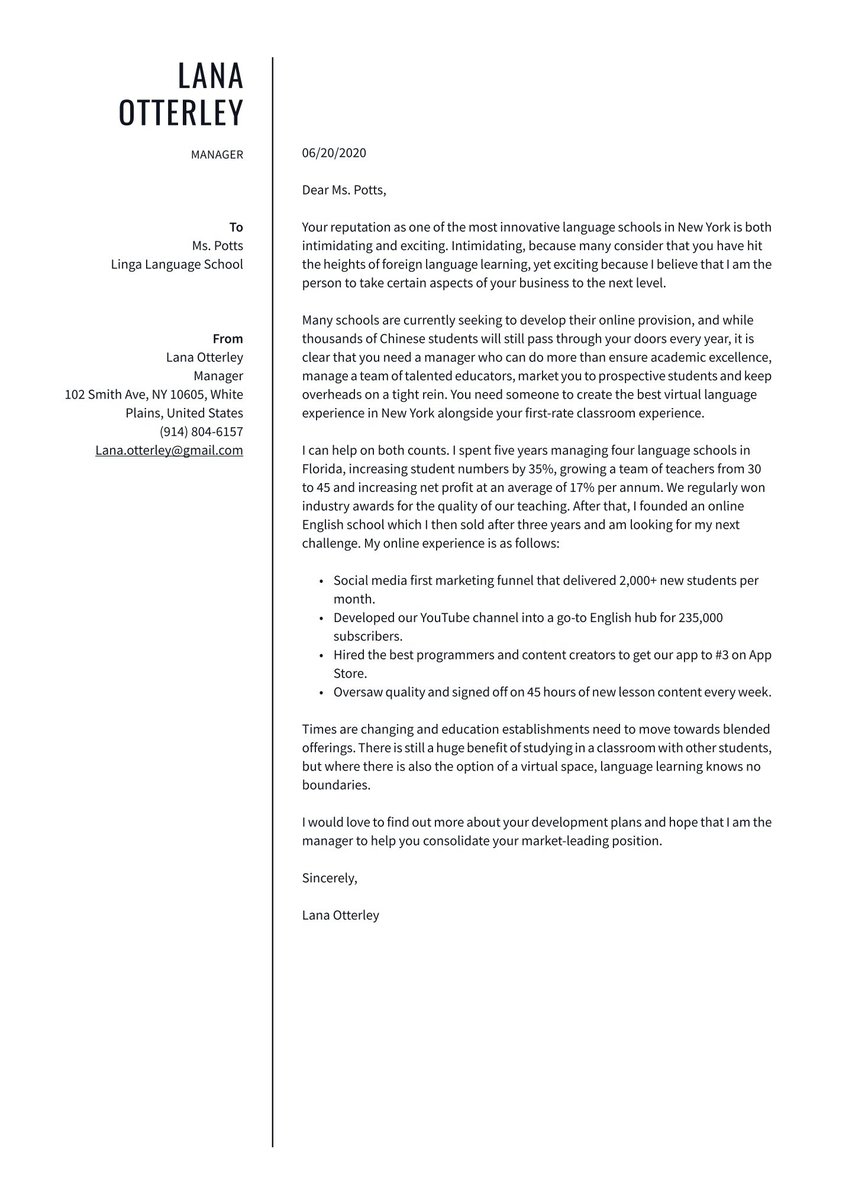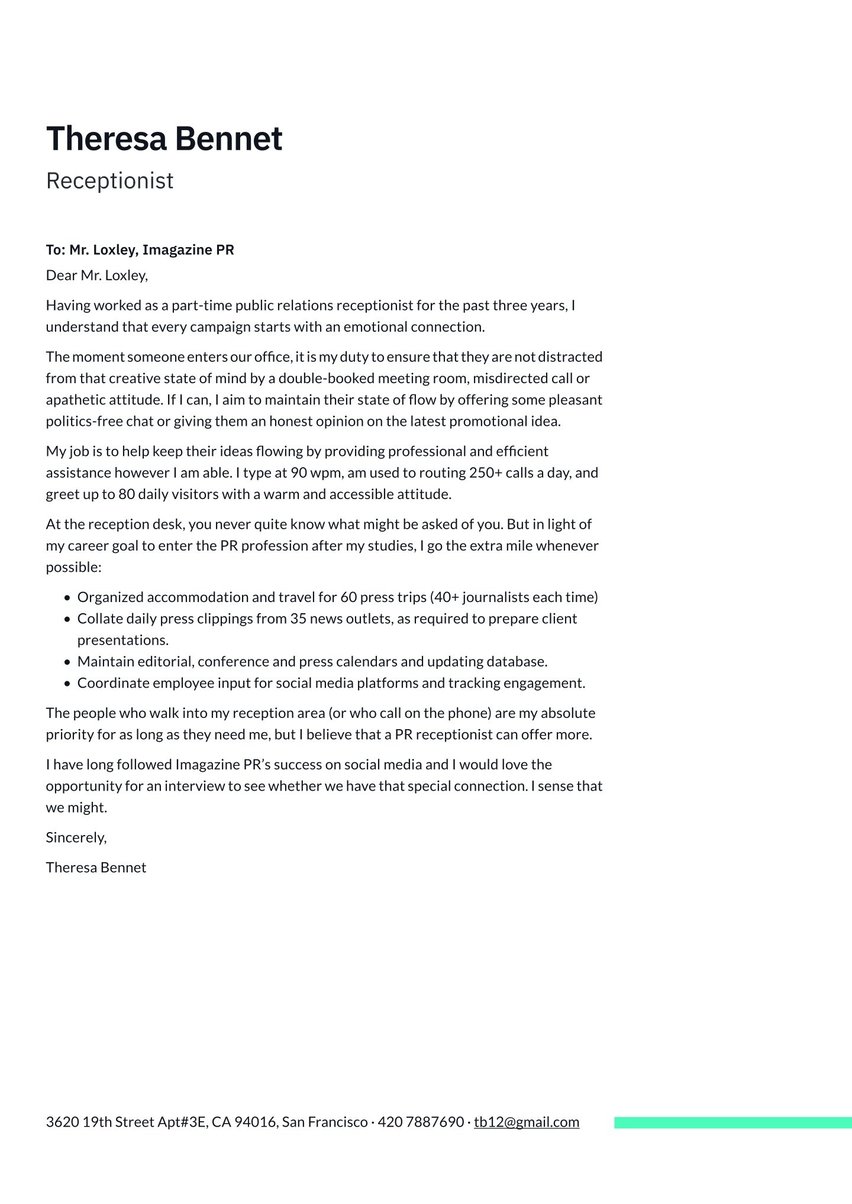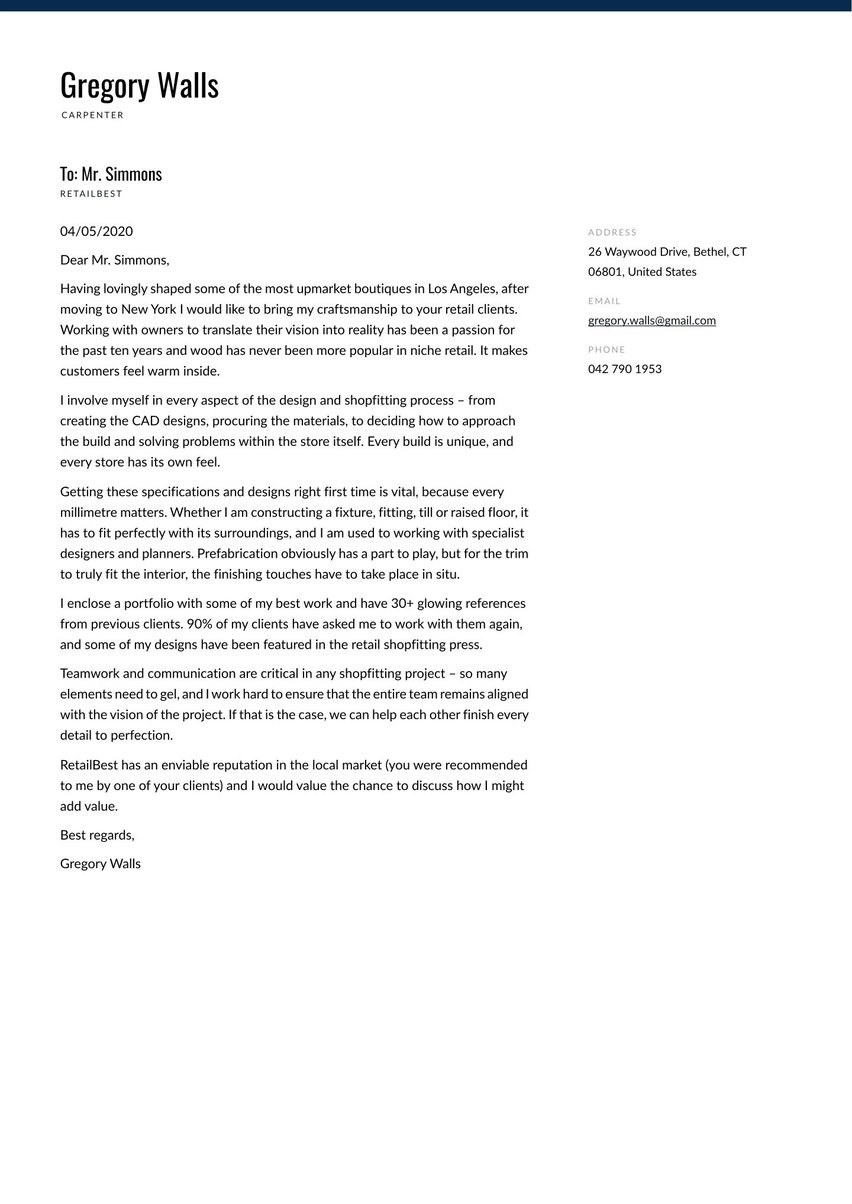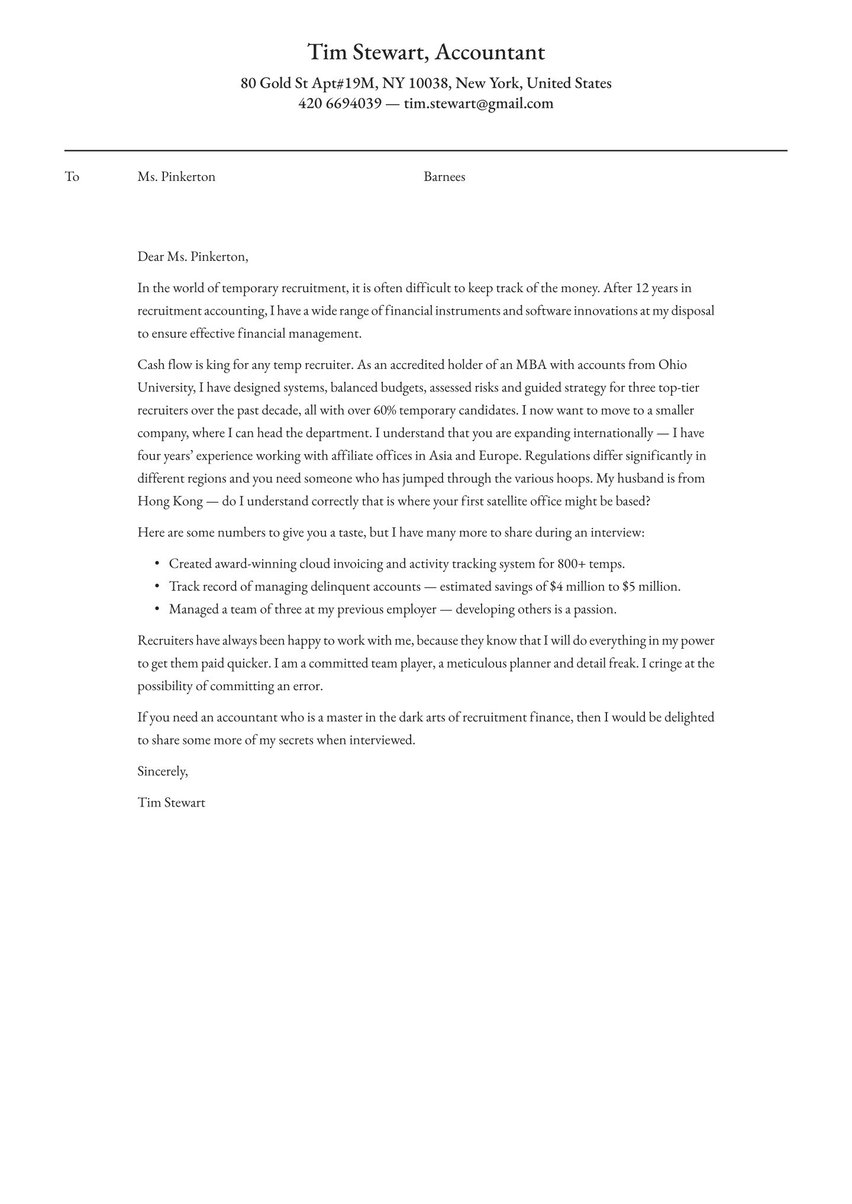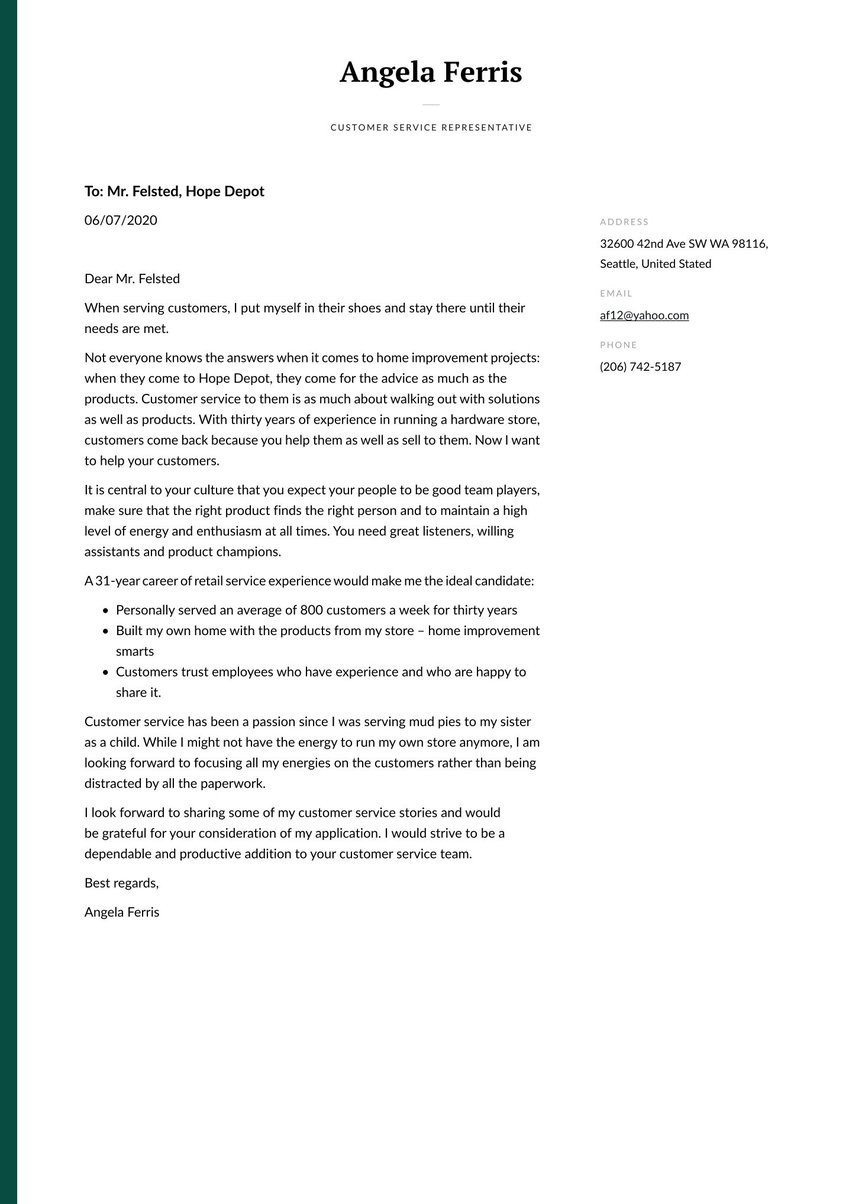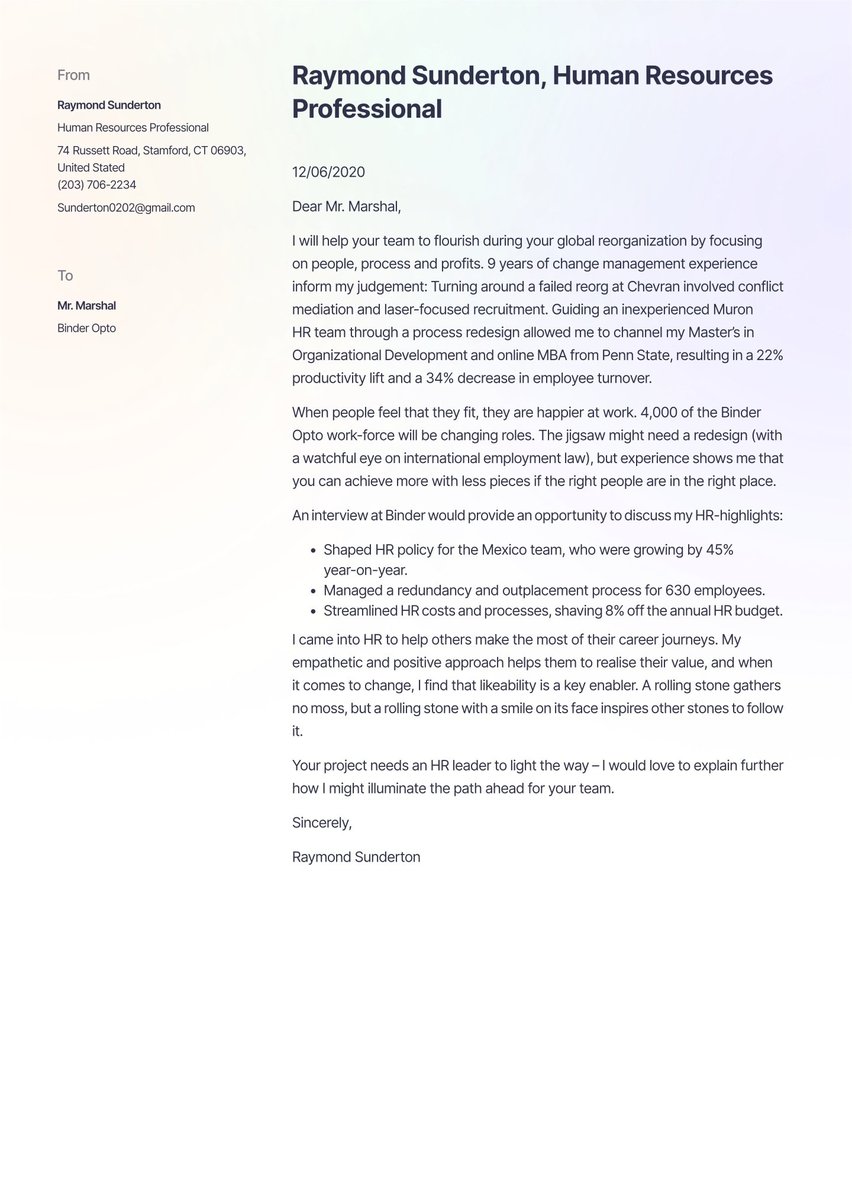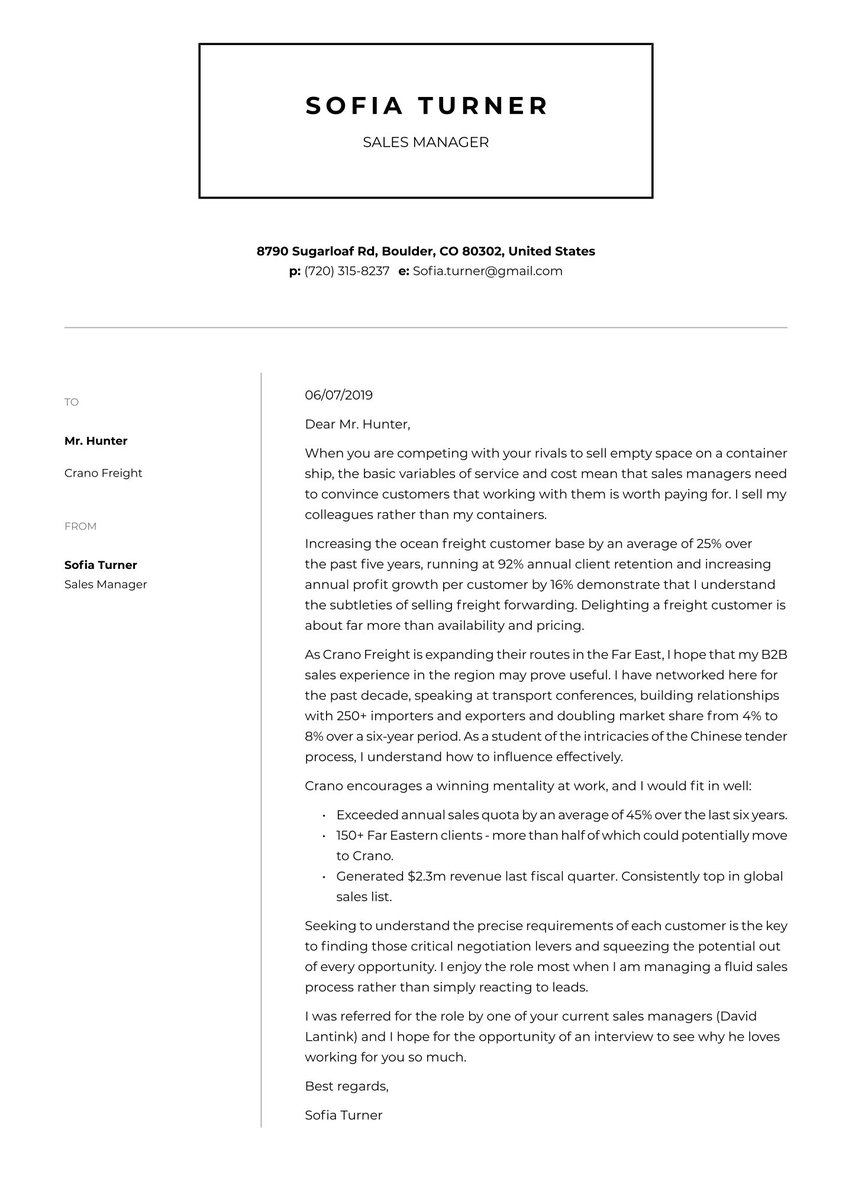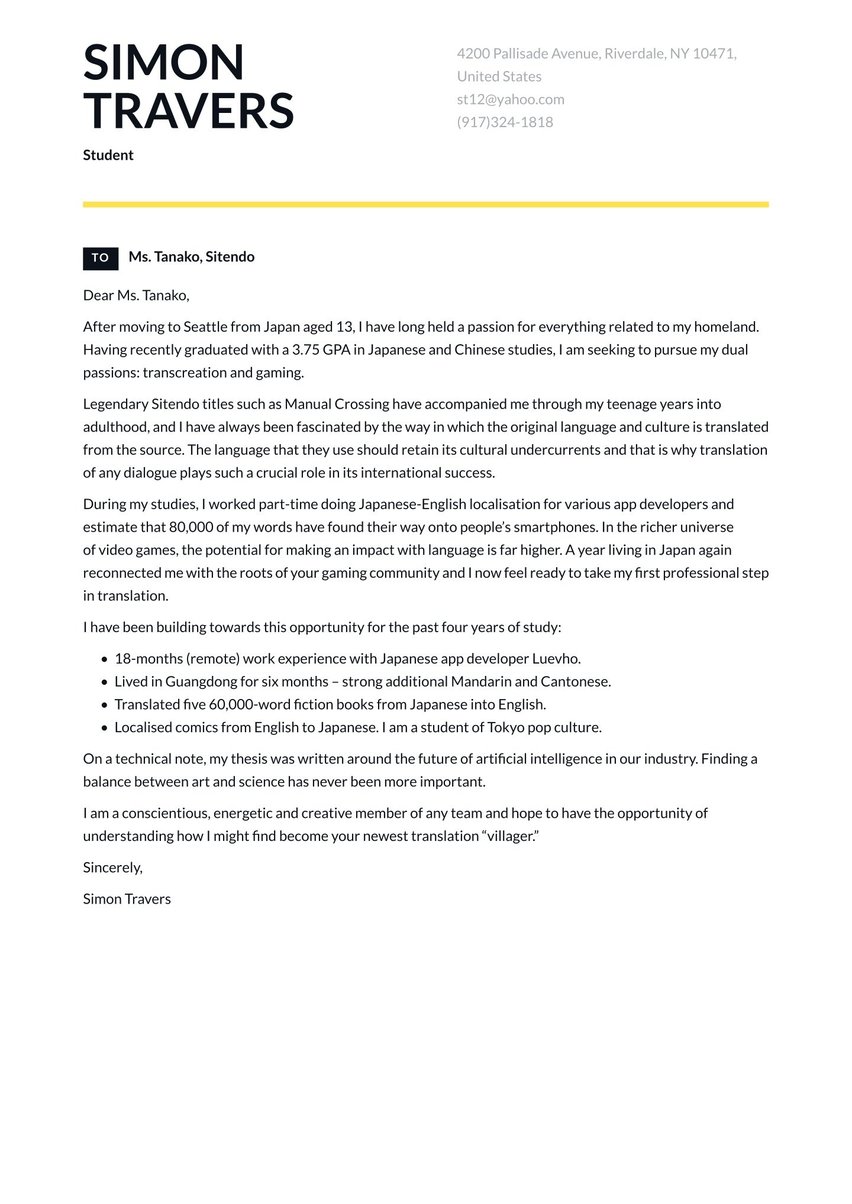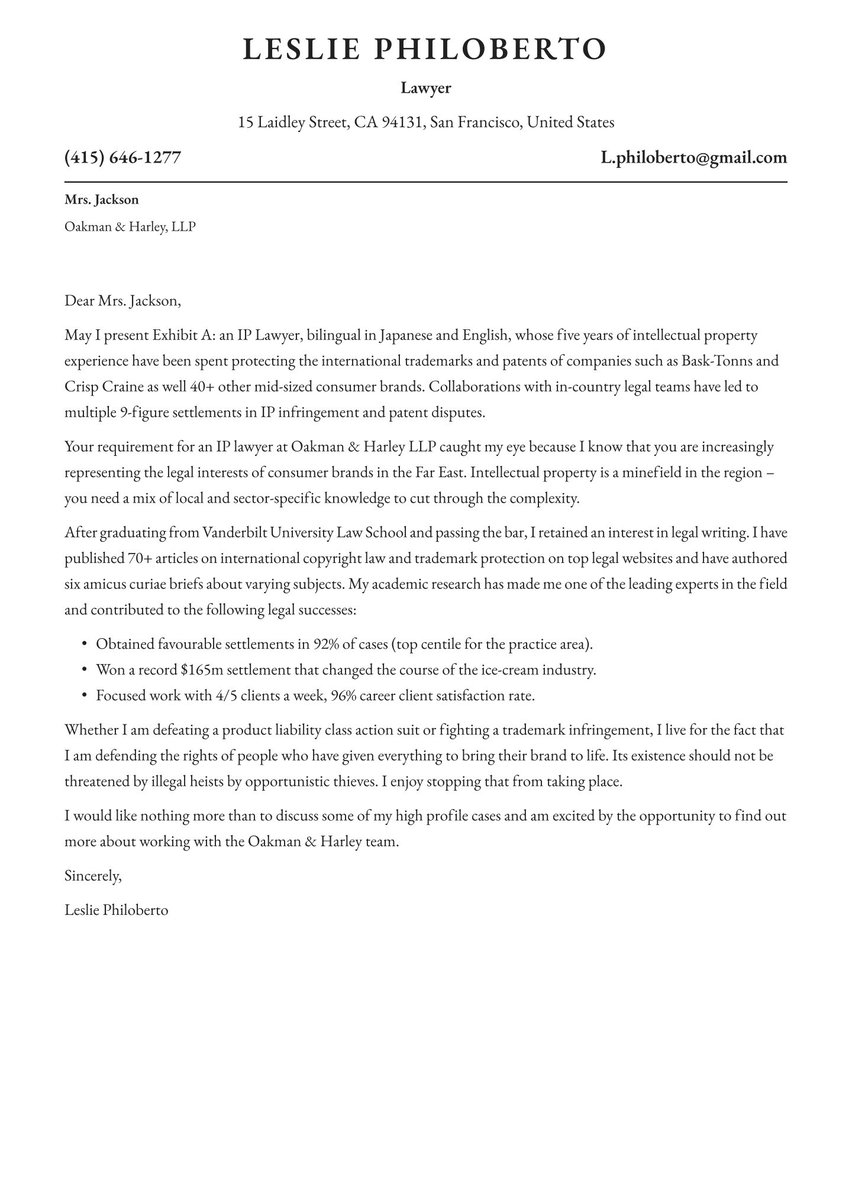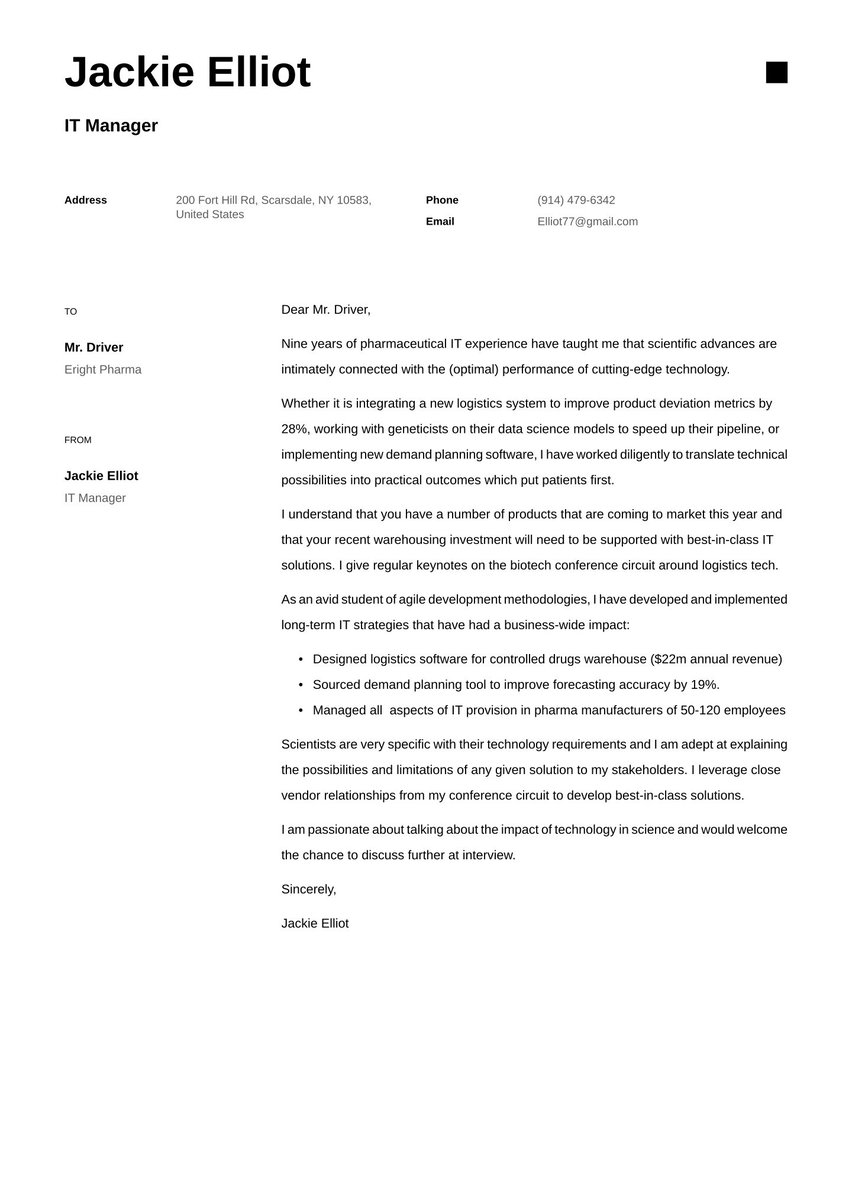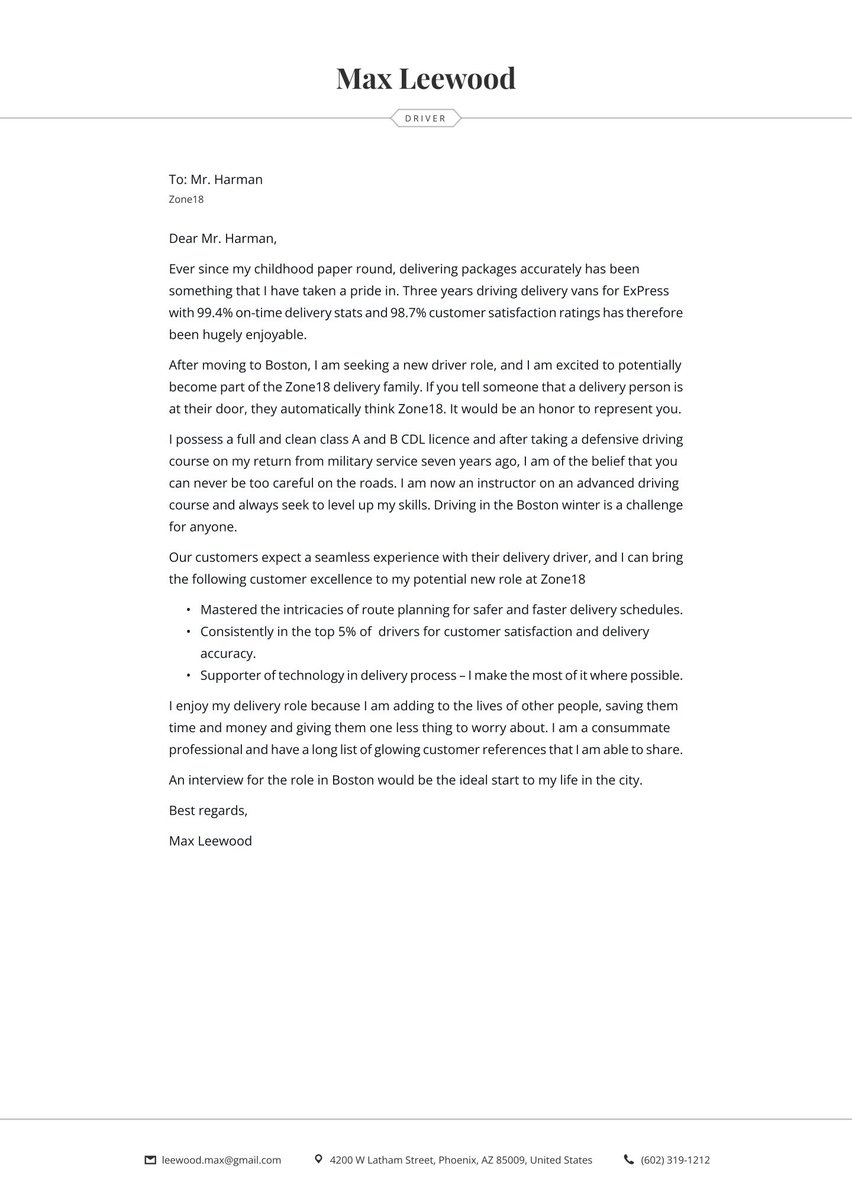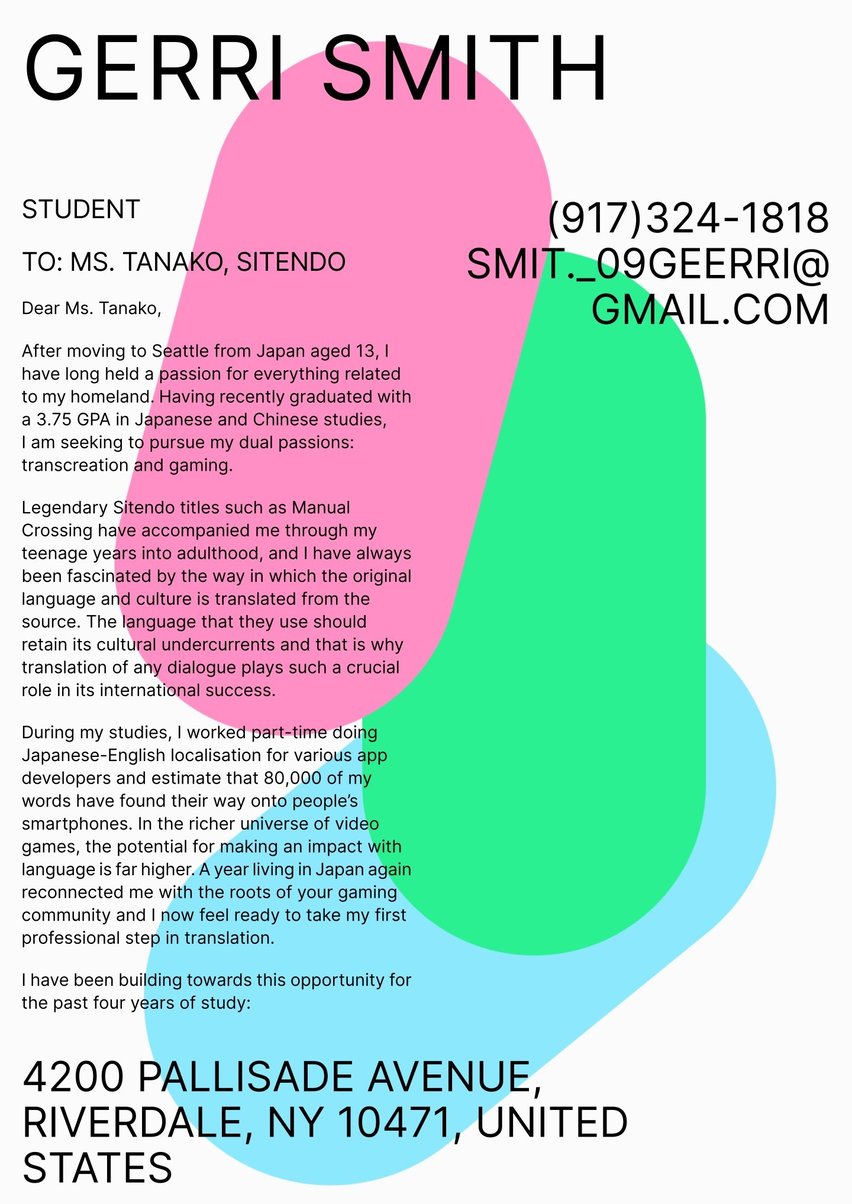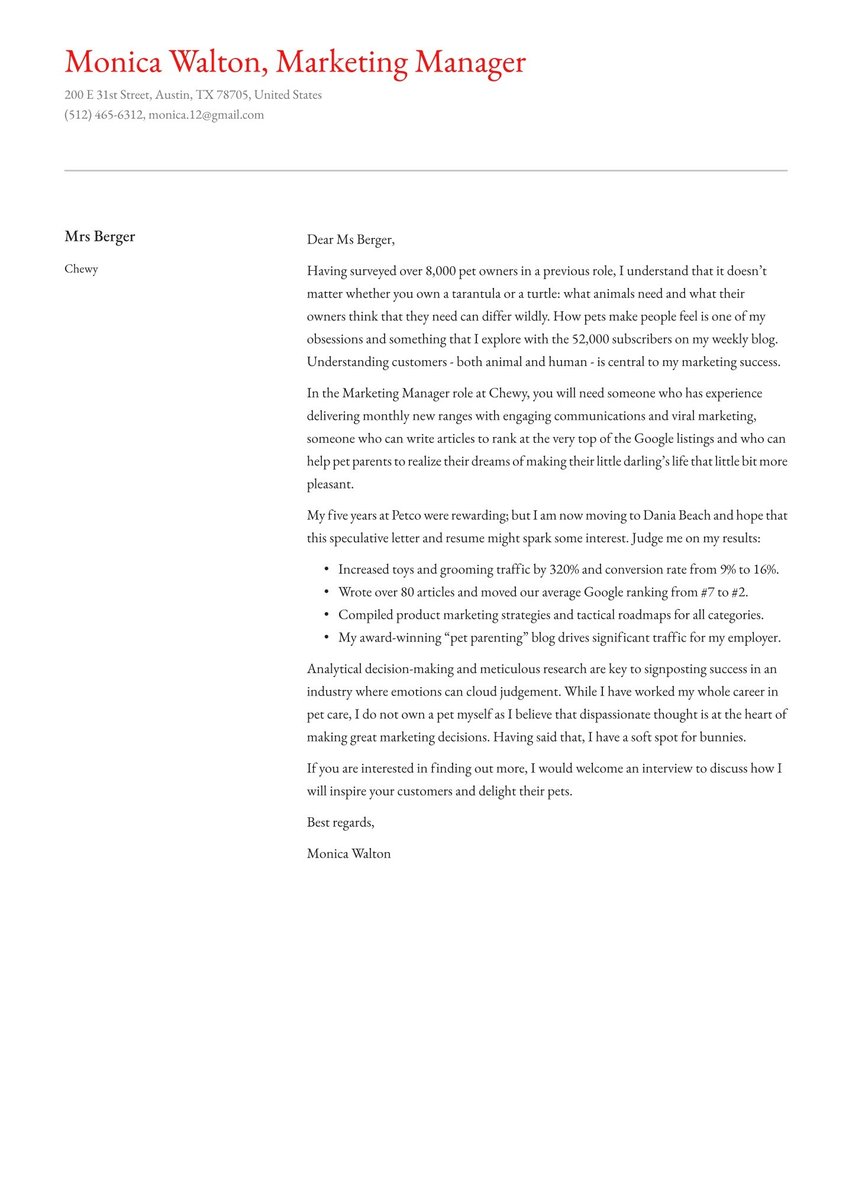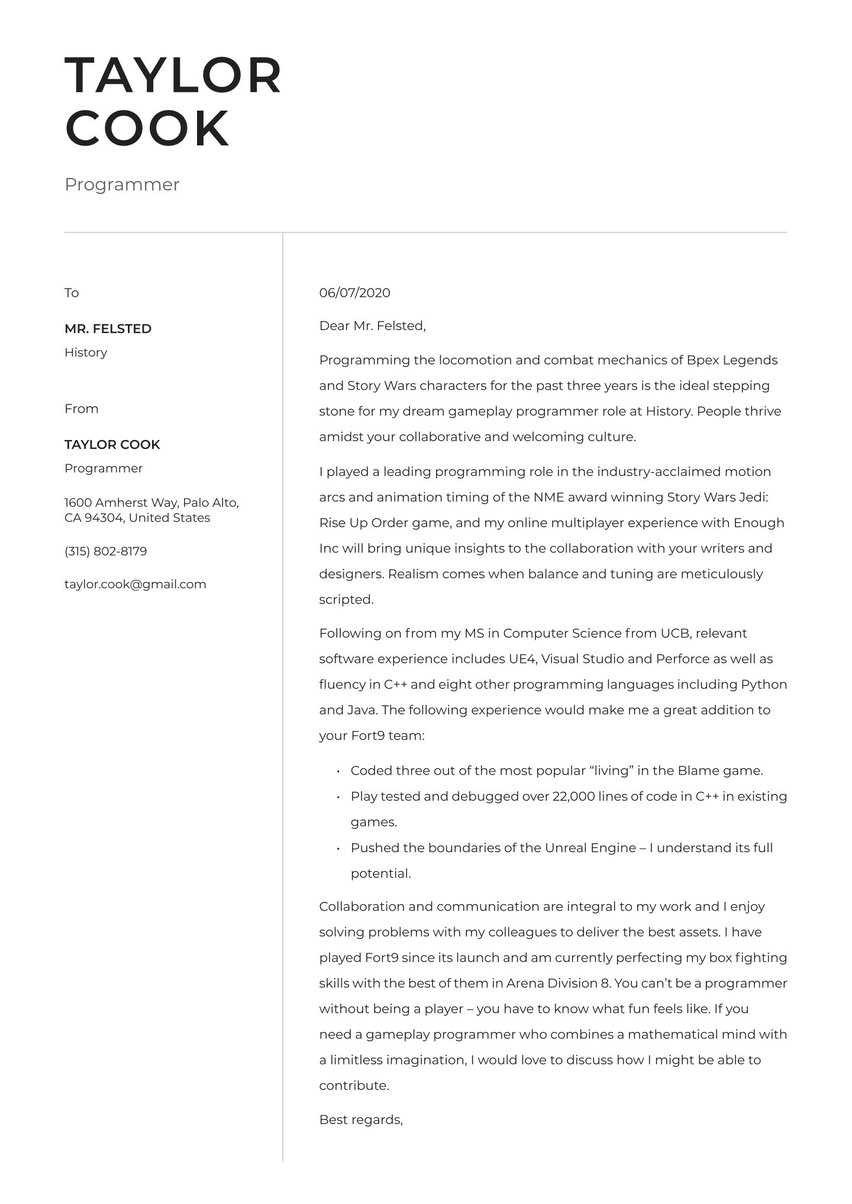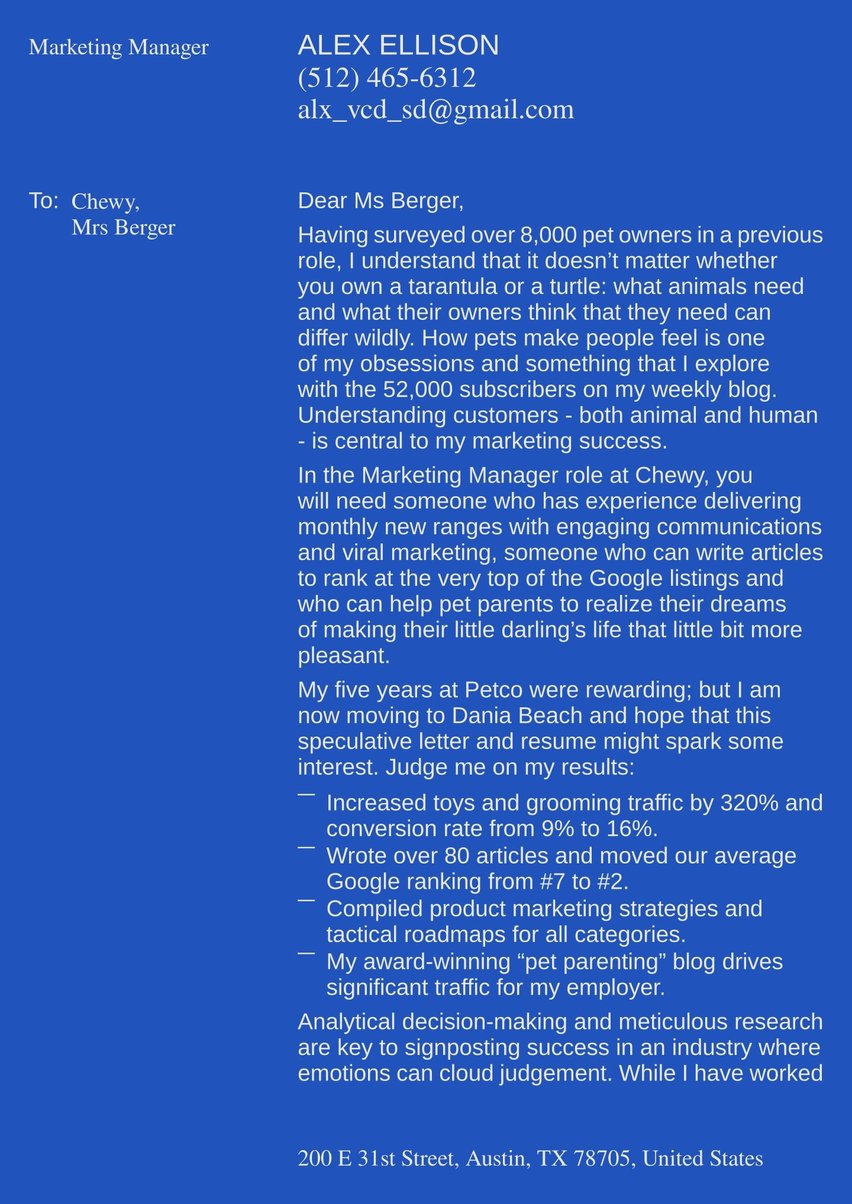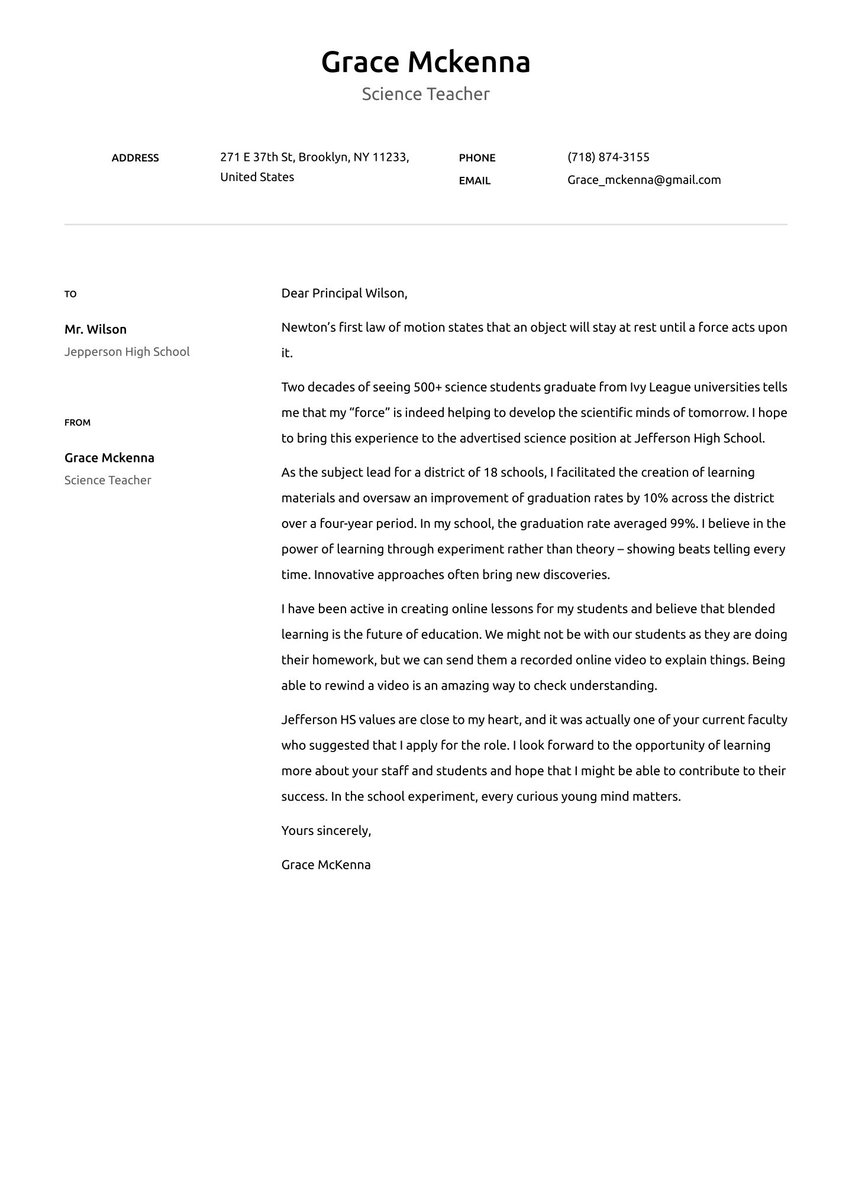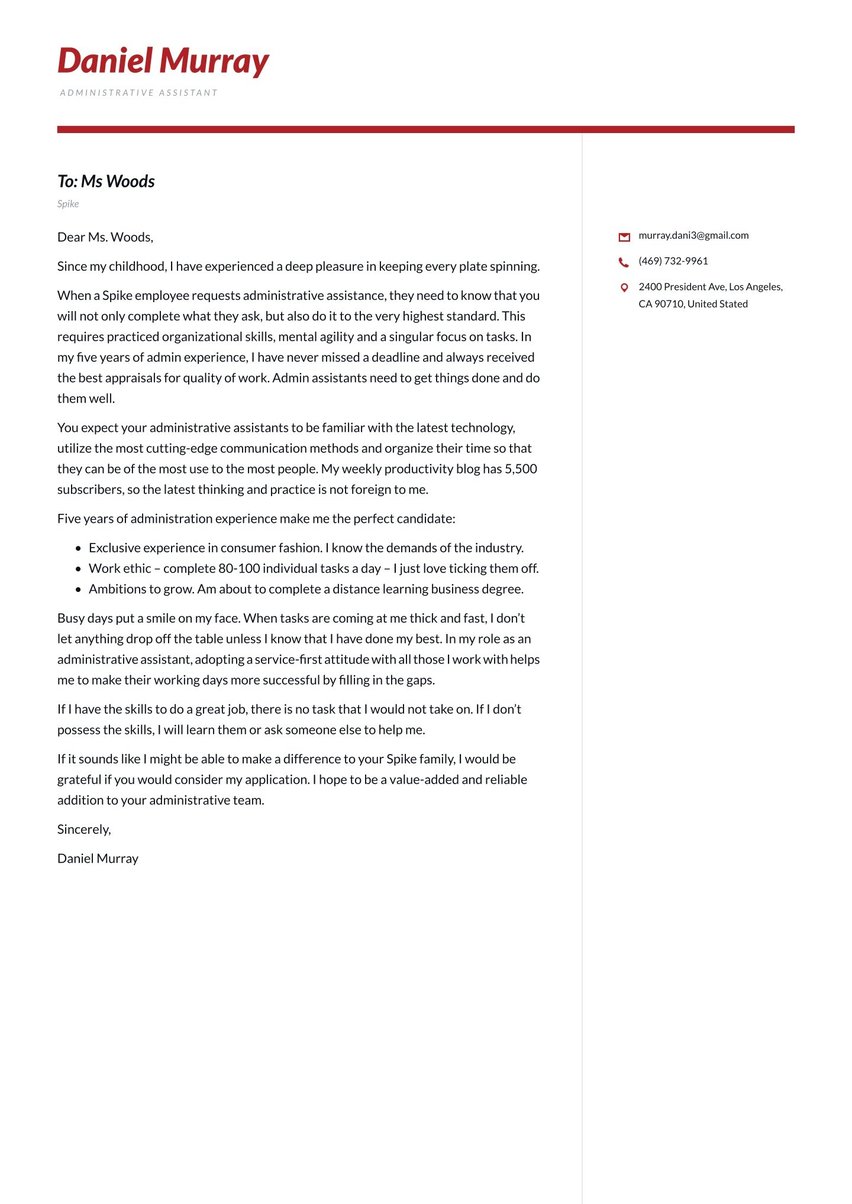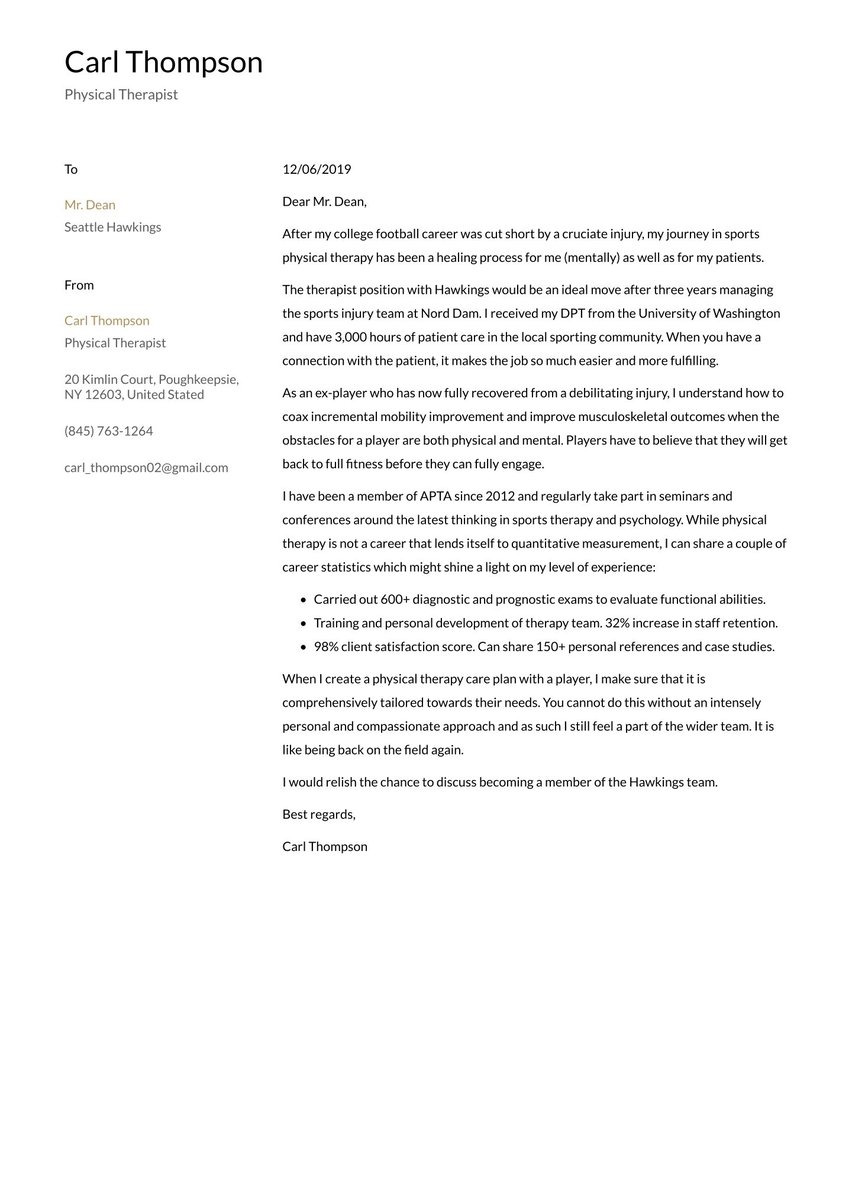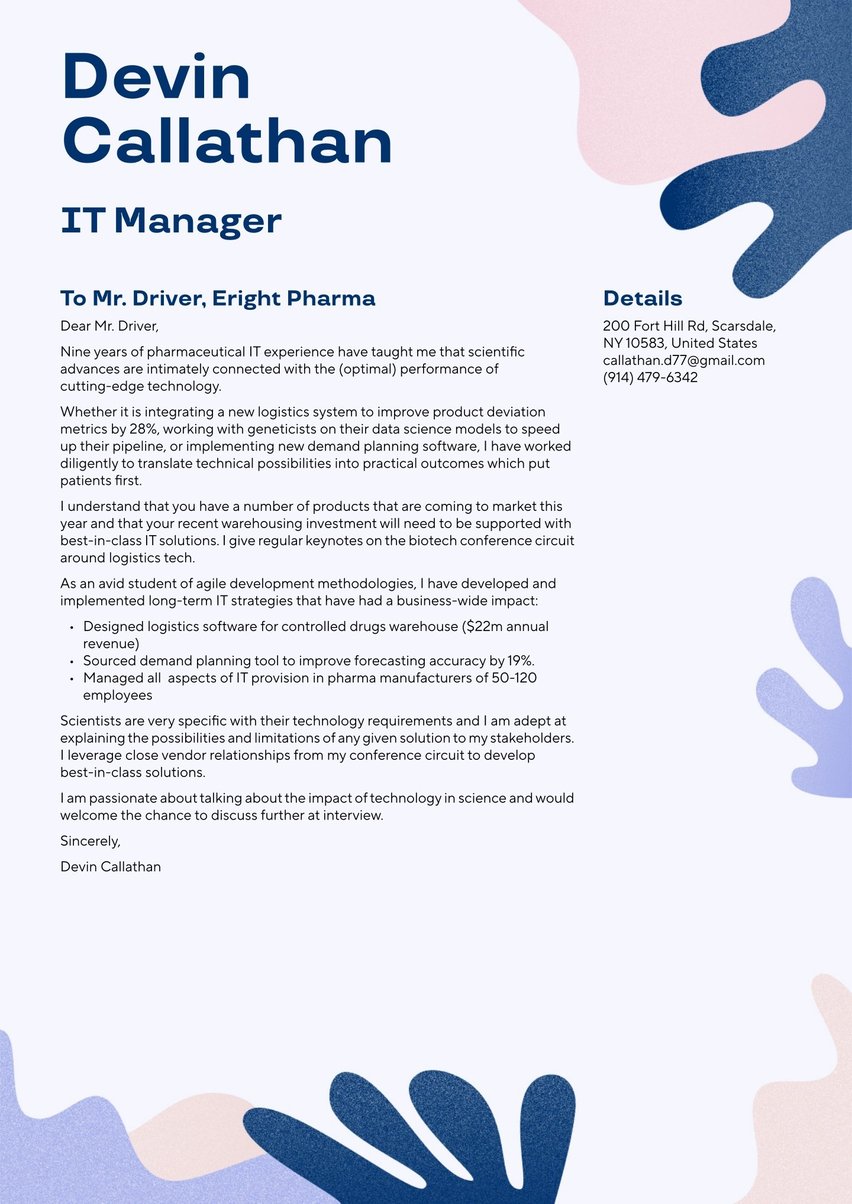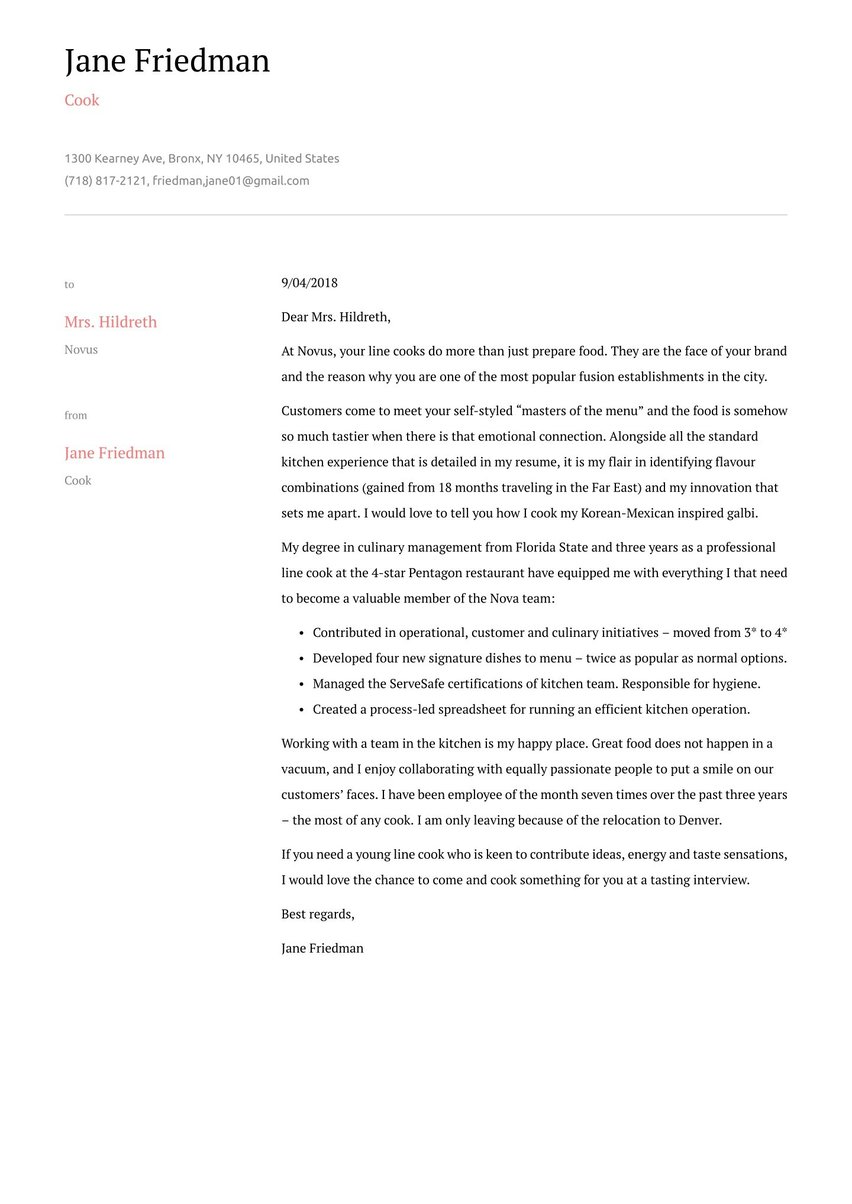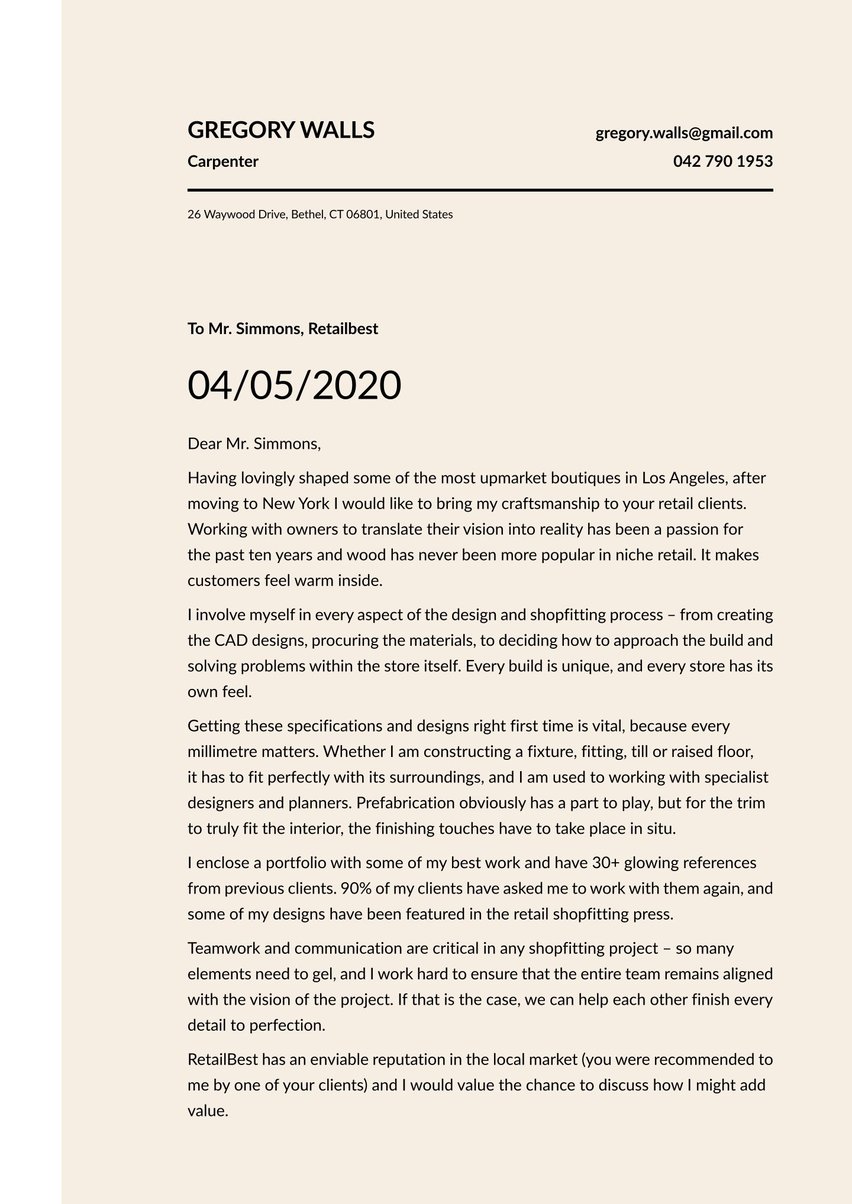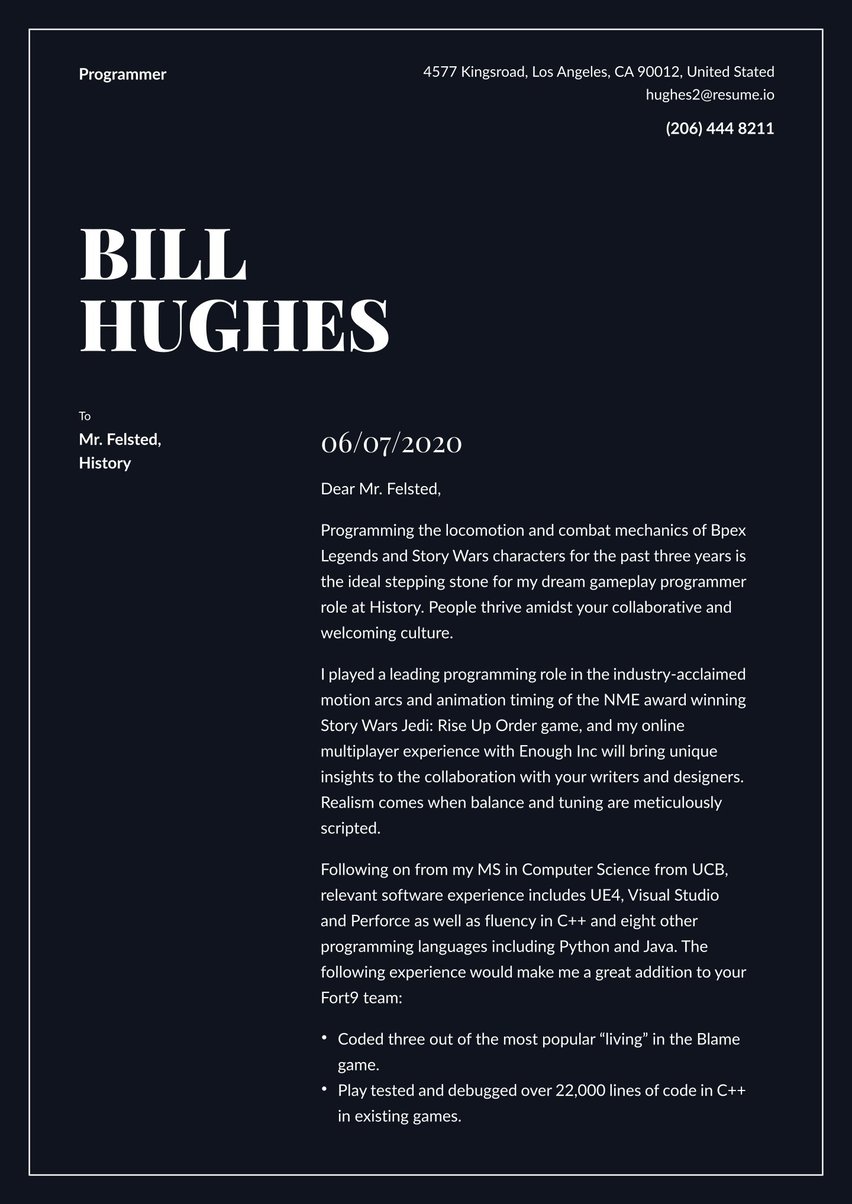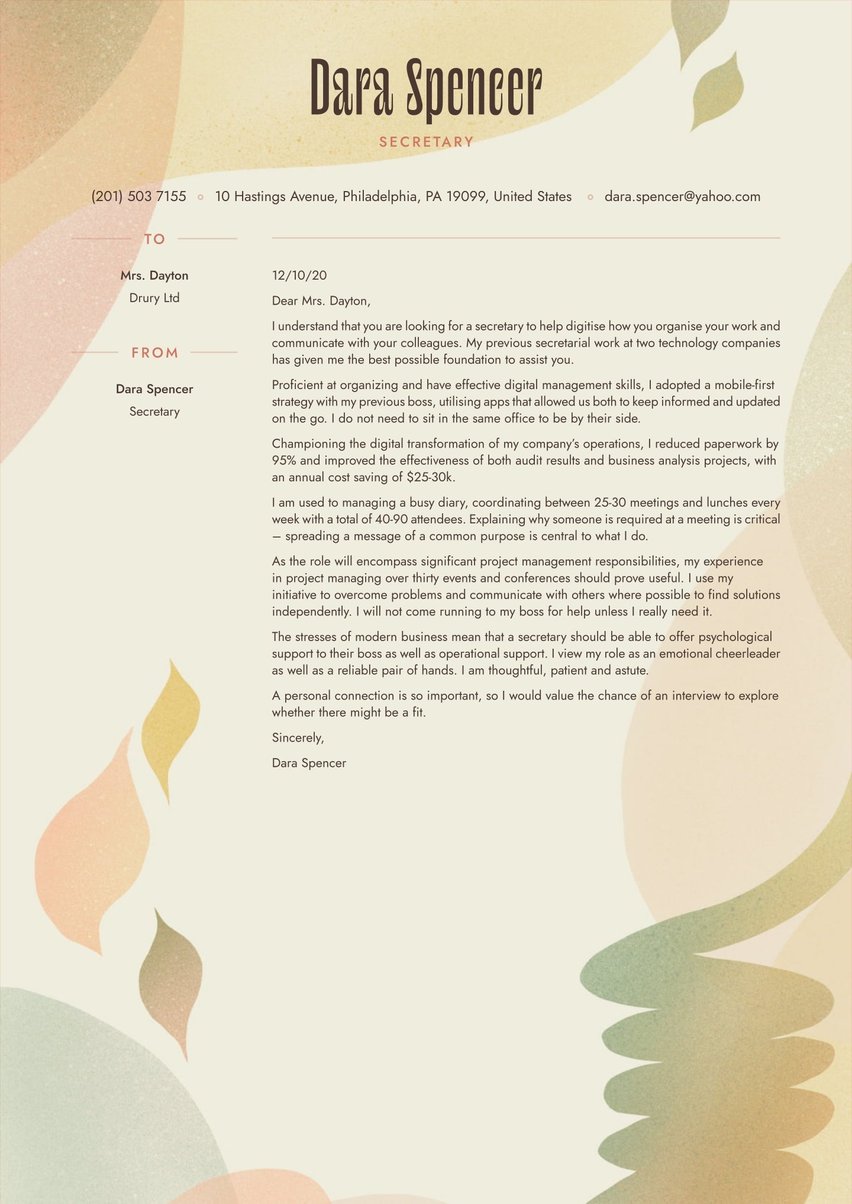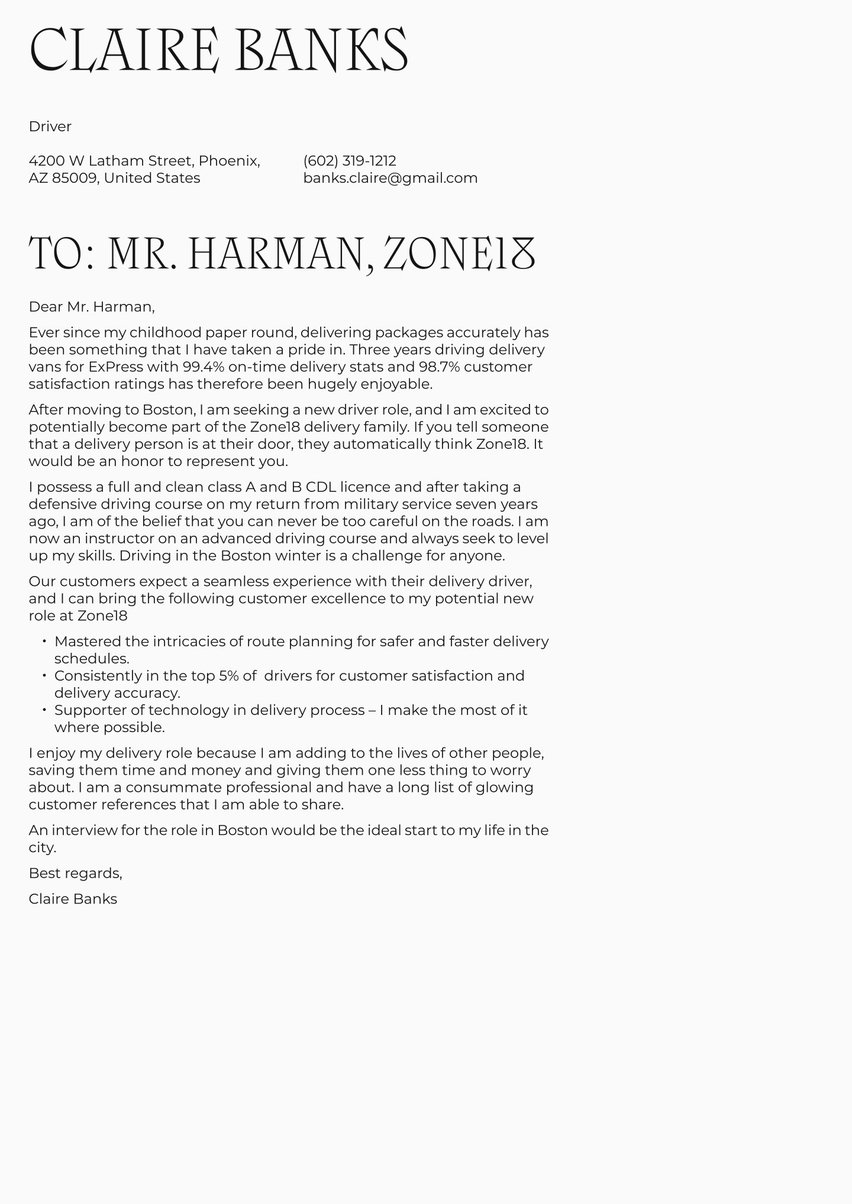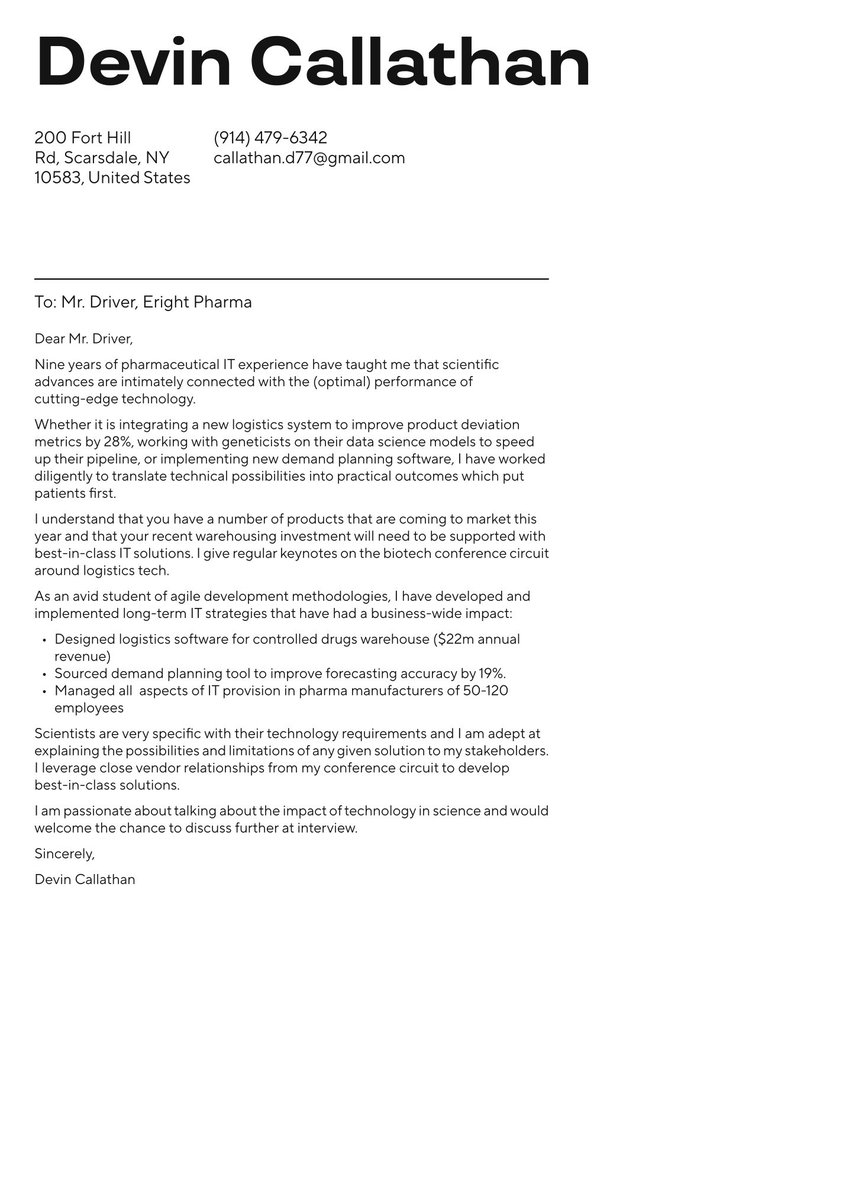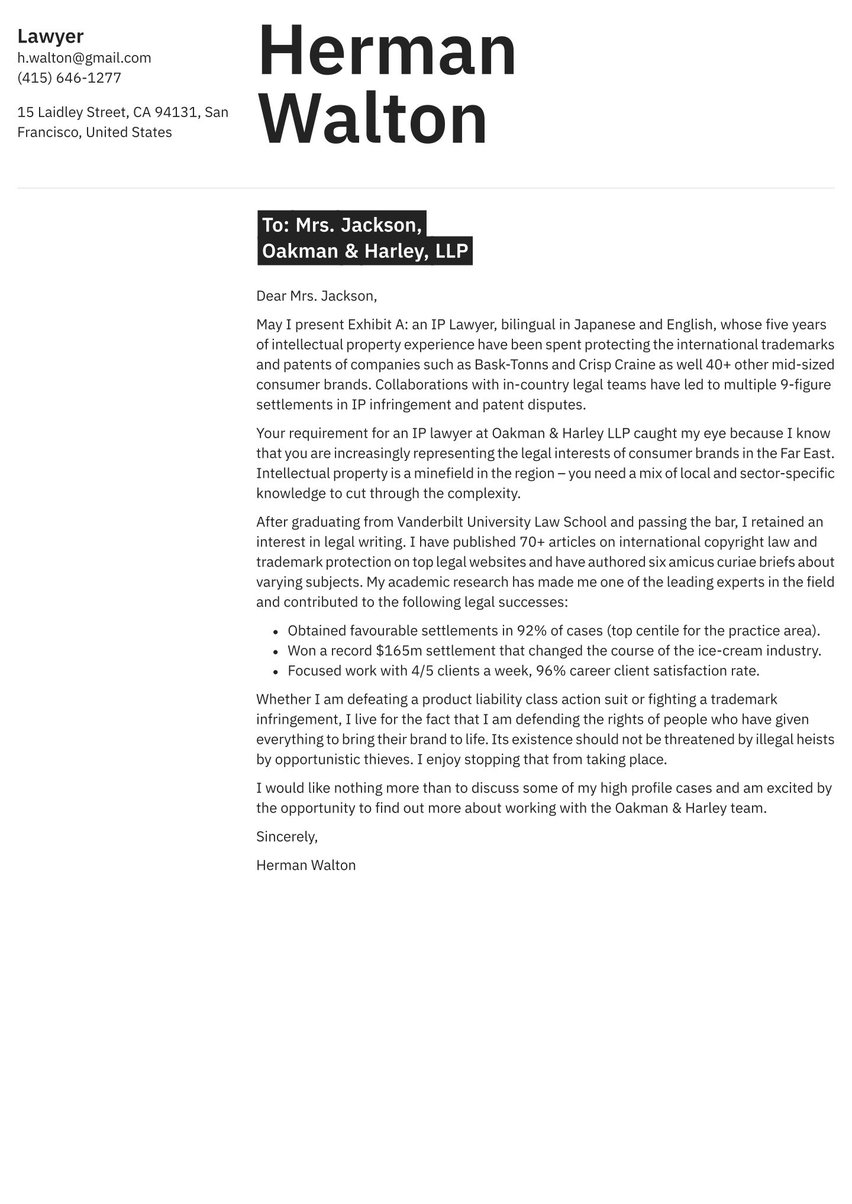Civil engineers design, build and maintain the infrastructure that we all depend on, including buildings, highways, bridges, dams, railways, water supply and sewage disposal. Whether you’re just starting out in this field or looking to jump ship to a better job, you’ll need an outstanding civil engineer cover letter to compete for a limited number of jobs in a competitive field.
Resume.io can help with that. We're a leading global provider of job search resources, including more than 180 occupation-specific cover letter examples and corresponding writing guides.
The guide you’re reading now is designed to help civil engineers prepare a one-page cover letter that makes a winning case for your candidacy.
With reference to an accompanying civil engineer cover letter example, we will discuss:
- Why a cover letter is crucial for a civil engineer
- The structure and components of a strong cover letter
- How to optimize the impact of each cover letter section: header, greeting, introduction, body, and conclusion
- Design and formatting rules for a well-designed cover letter
- Tips to writing a persuasive cover letter
- Some common mistakes you need to avoid
Why a cover letter is so important
The purpose of a cover letter is to introduce yourself to a potential employer and build a convincing case that you are an excellent candidate for the job.
In just one page, a maximum of 400 words, your cover letter should highlight the experience, skills and qualifications that make you a great civil engineer.
But shouldn’t your resume already highlight all of those same things? Yes, it should, but it does so in a much more impersonal way. A resume isn’t addressed to anyone, it doesn’t include the word “you,” and it’s mostly a collection of lists (like employers, schools and skills).
A cover letter is a much more personal document, showcasing your personality, passion, likability and perhaps even sense of humor. You can tell stories in a cover letter. You can speak directly to a hiring manager, as if you were having a face-to-face conversation. And you can directly address the employer’s specific needs.
A survey by the Harris Poll for CareerBuilder asked 1,138 hiring managers about the biggest resume mistakes commonly made by job applicants. One of the top deal breakers was the failure to include a cover letter.
In almost all cases, a cover letter is expected in a job application, so you’re shooting yourself in the foot if you don’t include one.
A small minority of employers will request a resume only, and of course you have to deliver what they want. But it’s their loss, because a cover letter offers valuable insights into the personal traits of the job applicant in ways that a resume alone can’t.
Unless you’re specifically asked not to, always include a cover letter with a job application. It’s a simple courtesy, and if done right it can only maximize your chances of landing an interview.
The job market for civil engineers
Some civil engineers specialize in project design, working primarily in offices, while others spend more time supervising on-site construction. Specialized fields include structural, environmental, transportation, geotechnical and municipal engineering.
The U.S. Bureau of Labor Statistics (BLS) projects job growth for civil engineers of 7% from 2021 through 2031, while the job outlook for all engineers, and in fact all occupations, is expected to be 5%.
BLS data indicates the median annual salary for civil engineers in the U.S. in May 2021 was $88,050.
Median annual wages in 2021 for civil engineers in the top industries that employed them:
Federal government, excluding postal service $100,730
Local government, excluding education and hospitals $99,330
Engineering services $93,520
State government, excluding education and hospitals $83,390
Nonresidential building construction $7,450
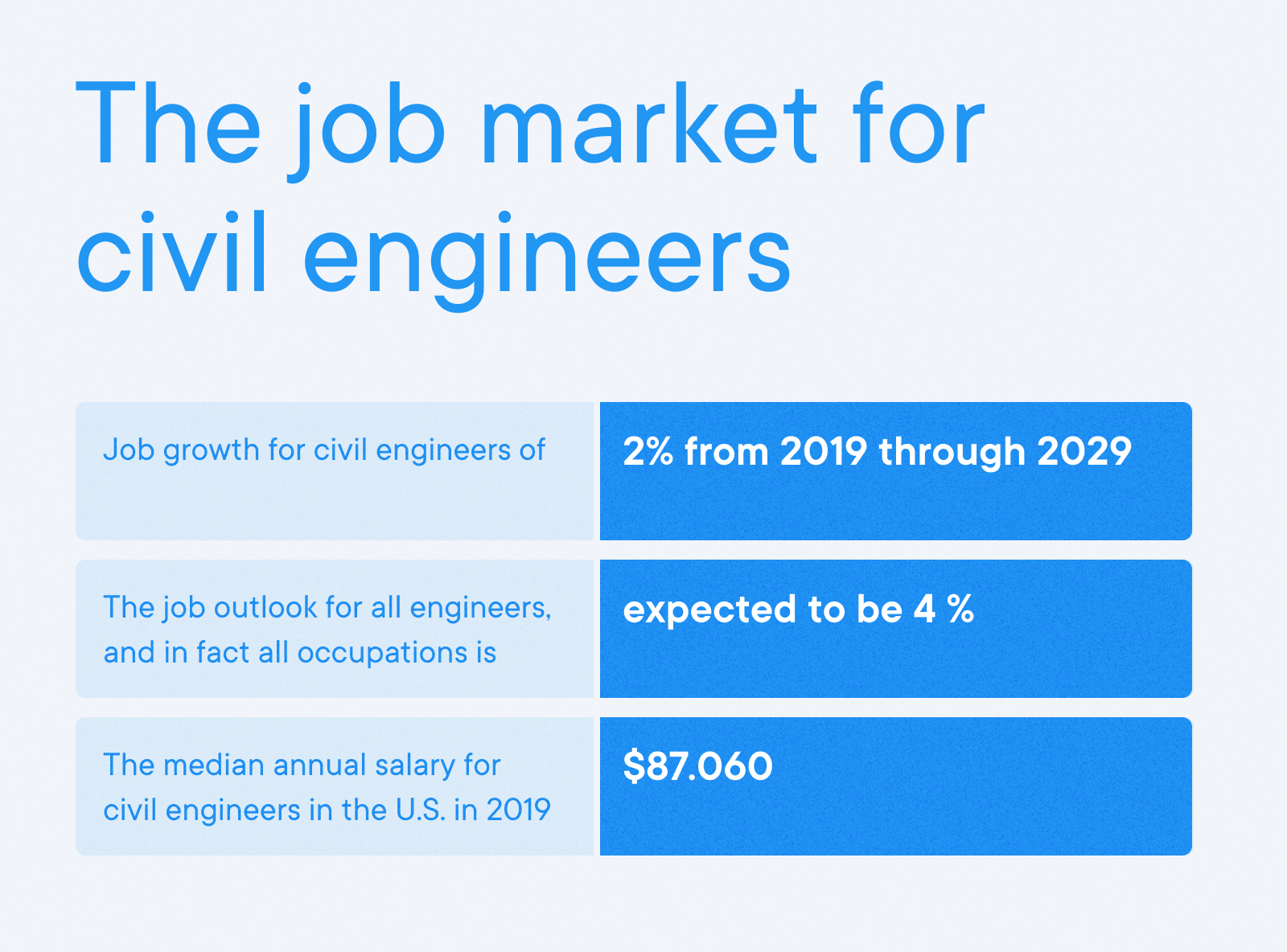
Civil engineers need at least a bachelor’s degree and a professional engineer license. A master’s degree in engineering is highly desirable in this field and generally required for supervisory roles.
Best format for a civil engineer cover letter
If there’s one thing we don’t need to explain to civil engineers, it’s the importance of good structure. Here is the “blueprint” for a well-built civil engineer cover letter:
- The cover letter header
- The greeting / salutation
- The cover letter intro
- The middle paragraphs (body of the letter)
- The ending paragraph of your cover letter (conclusion and call-to-action)
Formatted this way, your civil engineer resume should provide an overview of how you approach your job and your engineering philosophy. Employers also want an idea of how you communicate with coworkers and project stakeholders.
Our comprehensive cover letter guide offers an overview of how to go about creating cover letters. But below you will find specific advice on making the most of each letter paragraph and section. As a starting point, here is a general civil engineer cover letter sample you can use as for inspiration:
Dear Mr. Trinity,
Having worked on some of the most high-profile SE projects in California for two blue-chip engineering firms, I am now looking to move to a smaller consultancy that specializes in seismic-related engineering solutions.
Project design experience in water, wastewater, roadway and other municipal infrastructure projects in California gave me exposure to a broad range of civic engineering projects with varying levels of complexity, team structures and financial constraints. In every project I was the lead engineer on the technical specifications. My creativity with AutoCAD and Civil 3D allowed me to propose solutions that were subsequently adopted in other states with high seismicity and high wind.
After receiving my BS in Engineering from Georgia Tech, I passed the FE, PE and SE exams from NCEES with distinction. I subsequently worked with the SEER committee to develop learning materials for creating safe structures and emergency responses.
I take pride in putting safety at the heart of my work. My papers on ductile design and base isolation were recognised in the industry press as worthy of inclusion in their SE training databases.
My practical experience as a project manager will bring much needed operational knowledge to your design teams, and my research interests should dovetail with the cutting-edge thought leadership that SE Innovations offers its clients. I am able to visualize solutions that are both practical and novel, recognizing that scientific ambition must meet physical reality.
From what I’ve learned about SE innovations at a number of industry events, your involvement with mentoring and education in the wider engineering profession is something that I would proudly participate in. Raising awareness in our industry can ultimately save lives.
I would welcome the opportunity to share my portfolio and discuss my thoughts for a brighter SE future during an interview.
Sincerely,
Neil Burrows
Cover letter header
Often the big words at the top of a document (the title) are the most challenging to write, but in this case it’s just your name.
The header, known in the old paper-and-ink days as a letterhead, is the text element at the top of your letter that includes your name, occupation, address, phone number and email. If you have a LinkedIn profile, website, or online portfolio of work samples, it’s a good idea to add the URLs to your cover letter header.
Some people nowadays omit their snail-mail addresses, especially for remote work that will be conducted electronically. But in most cases, it’s best to include a mailing address unless there’s a good reason not to, or at the very least the city, state and/or country where you live.
The main purpose of the header is to make it easy for the employer to know how to contact you. But it serves an important secondary purpose as a design element, making your page more attractive at a glance.
The header design might include a splash of color, an innovative layout, and creative use of typography and white space. It will help make your letter look good at a glance, before the recipient reads the first word.
Align document styles
A resume and cover letter should be designed to go together, like the two marble lions at the entrance to the New York Public Library. There’s a reason they didn’t sculpt one lion and one hyena. Good design thrives on consistency, coherence and parallelism.
To make your resume and cover letter a “matching set,” use the same fonts, font sizes and formatting styles for both. They should have a similar look and feel, and it should be obvious that these two documents came from the same person at the same time.
If your resume and cover letter are a mismatched riot of fonts, colors and styles, your reader may rightfully question your attention to detail and your eye for design. It may look like you wrote a new cover letter but carelessly attached an old resume.
But if you make them match, it will give you a “visual brand,” reassuring the reader that you understand the importance of thoughtful, coordinated design.
The aim of the cover letter header: Highlight your contact details, efficiently, and elegantly. Catch the eye of the hiring manager.
Cover letter greeting
Some people think the word “Dear” is a bit old-fashioned, but has anyone ever really improved on it? In the age of email, salutations like “Greetings Engineering Team” or “Hello Max” may be more common, but that doesn’t make them better. You will notice that in our cover letter example above, we stick to the "old-fashioned" greeting of "Dear."
“Dear Mr. [or Ms.] [Last name here]” is a bulletproof greeting for any cover letter. You simply can’t go wrong with this.
If you happen to know the person you’re writing to, there’s nothing wrong with addressing that person by first name. But beware of being too casual in a letter where you’re asking for a job.
Speaking of names, if you don’t know the name of the appropriate person to write to, that’s a common problem. Find an uncommon solution by doing your homework to figure out who that person is. If all your web searches can’t answer the question, consider making a phone call to the company to inquire.
People get a little psychological boost out of reading their own names — plus you’re more likely to get a reply to an email written to a named individual than one addressed to an entire company. And again, it shows your professionalism and attention to detail if you’ve gone to the trouble of finding out who’s responsible for hiring at the company you’re targeting.
The aim of letter greeting / salutation: Start your letter off with a formal, yet personal, greeting to set the tone for your application.
Cover letter introduction
The first paragraph of your cover letter has to get the reader’s attention from the start, both identifying the job you’re seeking and beginning to make your case that you’re the right candidate.
You need to find the right tone, neither too bland nor too boastful, using provocative, lively language.
The aim of the cover letter intro: Get your main message across succinctly and ensure hiring managers know that you understand the job for which you are applying.
Below you’ll see the greeting and introduction from our civil engineer cover letter. Notice that the introduction gets the candidate's background and motivation for seeking a new job all into one sentence:
Dear Mr. Trinity,
Having worked on some of the most high-profile SE projects in California for two blue-chip engineering firms, I am now looking to move to a smaller consultancy that specializes in seismic-related engineering solutions.
Cover letter middle part (body)
The central two or three paragraphs of your cover letter must build a convincing case that you have the experience, qualifications and skills for the job.
Experience is key in any field, so you should generally lead with your proven track record as a working professional. Describe not just where you worked and for how long, but list your specific achievements on the job, using facts and figures where possible. Also provide anecdotal evidence for your talents by telling stories about thorny challenges you’ve faced in the past and how you resolved them.
If you’re still in college and applying for your first job in this field, it may be appropriate to lead with your academic record, while mentioning any internships or other relevant experience. But even if you’ve been working as a civil engineer for years, you’ll probably want to mention your university degree and any certifications or licensure you hold.
As much as possible, speak to the specific needs of the employer you’re writing to, and talk about how your contributions could help address them. Demonstrate that you’ve studied the company or agency where you want to work, and that you aren’t just blindly sending the same cover letter to multiple employers.
The aim of the body of your cover letter: Offer your vision for civil engineering projects and what it is like to work with you and for you. Give an overview of your qualifications and hone in on skills specific to the job you seek.
The civil engineer cover letter body example below lists several skills and specialties.
Project design experience in water, wastewater, roadway and other municipal infrastructure projects in California gave me exposure to a broad range of civic engineering projects with varying levels of complexity, team structures and financial constraints. In every project I was the lead engineer on the technical specifications. My creativity with AutoCAD and Civil 3D allowed me to propose solutions that were subsequently adopted in other states with high seismicity and high wind.
After receiving my BS in Engineering from Georgia Tech, I passed the FE, PE and SE exams from NCEES with distinction. I subsequently worked with the SEER committee to develop learning materials for creating safe structures and emergency responses.
I take pride in putting safety at the heart of my work. My papers on ductile design and base isolation were recognised in the industry press as worthy of inclusion in their SE training databases.
My practical experience as a project manager will bring much needed operational knowledge to your design teams, and my research interests should dovetail with the cutting-edge thought leadership that SE Innovations offers its clients. I am able to visualize solutions that are both practical and novel, recognizing that scientific ambition must meet physical reality.
From what I’ve learned about SE innovations at a number of industry events, your involvement with mentoring and education in the wider engineering profession is something that I would proudly participate in. Raising awareness in our industry can ultimately save lives.
How to close a civil engineer cover letter (conclusion and sign-off)
The last paragraph of your letter should provide a satisfying summary of your pitch, perhaps a thank-you for your correspondent’s time, and also some kind of call to action. You want to plant the thought in the reader’s mind that you are eagerly awaiting a reply, ideally one that invites you to an interview. Find a strong close that compels the reader to respond.
Close your letter with a simple “Sincerely,” “Best regards” or the equivalent, and type your full name below that. If sending your letter electronically, you can add a digital signature if you choose, though it’s not considered necessary.
The aim of the cover letter closing: Tell your future employer why you are the engineer for the job and request an interview.
The closing from our civil engineer cover letter example offers the candidate's philosophy of the importance of the job and tells the hiring manager why the writer wants to work at that company.
I would welcome the opportunity to share my portfolio and discuss my thoughts for a brighter SE future during an interview.
Sincerely,
Neil Burrows
Civil engineer cover letter design and formatting
It is possible to build a sound structure with a totally unappealing design, but this is obviously an error you want to avoid. Follow these formatting guidelines to make your civil engineer cover letter look as good as it reads.
- Fonts: Choose a modern font that is easy to read and easy on the eye — nothing garish or avant-garde. Make the font size no larger than 12 points and no smaller than 10. If your first draft doesn’t fit onto one page, cut your text before you resort to formatting solutions like downsizing the font for your cover letter.
- Text alignment: All text should be aligned left, not justified from margin to margin, to avoid a blocky look.
- Paragraphs: Do not indent paragraphs, leave a space between them, and don’t make them too long. Nobody wants to read a paragraph that’s 20 lines long.
- Margins: Leave a one-inch margin on the left, right, top and bottom so that your cover letter doesn't feel cramped.
- Save as a PDF: Unless you’re asked to submit your cover letter and resume in some other format, always send them as PDFs, which will preserve your formatting so that your documents look the same on any device.
- Use a template: To avoid these potential pitfalls, use a professionally designed template like those we offer at resume.io.
How to craft a persuasive civil engineer cover letter
Always remember that you’re writing your letter to a human being, so don’t write like a robot. A cover letter is a formal business letter, but that doesn’t mean it shouldn’t be personal. A civil engineer cover letter is bound to get a tiny bit technical, but the human behind the document should still shine through.
Humans have both hearts and heads, and psychologists say that we process stimuli using both rational and emotional responses. Hiring managers will scour your civil engineer cover letter for the rational reasons that make you a strong candidate, such as your experience, education and training.
But heartfelt language like “What I love to do most…” or “My greatest passion…” or “I would be delighted…” will humanize you and trigger emotional responses in your reader. At times, sharing personal details (like you want to move to San Jose because your first grandchild was just born there) will also strike a chord with the person reading your letter.
Robotic language often leads to clichés: “As both a self-starter and a team player who works well with others, I am accustomed to thinking outside the box.” Delete these timeworn phrases and write in fresh, original language that you thought up all by yourself. A cover letter of a civil engineer doesn’t have to be dry or stale. It doesn’t have to be overly formal either. Find the balance between discipline and personality.
You get just one page to say everything you need to say, so make every word count. Be sure you’ve included your most impressive accomplishments and milestones, be specific, and leave out anything that doesn’t need to be included.
When you think you’re done, put yourself in the shoes of the hiring manager and reread your letter. Does it strike the right tone, neither too brazen nor too understated? Is there any part of your letter that sounds arrogant or off-key? Does it contain anything that’s irrelevant? And if you received this letter, would you want to meet the person who wrote it, and perhaps work with him or her for years to come?
If this is your entry into the job market, take a look at our first job cover letter example.
Common mistakes in a civil engineer application letter and how to avoid them
We all make mistakes! When writing a cover letter for a civil engineer, here are some of the most common cover letter mistakes to avoid:
- Typos and other writing errors: Bad spelling, grammar and punctuation are a major turnoff, if not a deal-breaker. Even though you’re not applying for a job as an English teacher, nobody wants to hire a civil engineer who makes glaring mistakes.
- Mass mailings: If you send the same cover letter to 50 employers, you should expect to remain unemployed. Every letter should be unique and written specifically for the employer you’re addressing.
- Generic wording and fluff: “Fluff” refers to overly complicated words and phrases that say nothing. It’s fine to use professional terms where appropriate, but just make sure that they deliver meaning rather than waste the hiring manager’s time. Clichés, HR-speak and corporate lingo will not endear you to any recruiter.
- Irrelevant info: If you enjoy baking, gardening and scrapbooking, nobody really cares.
- Your letter looks terrible: Unattractive formatting (weird fonts, tiny font sizes, gigantic paragraphs, inadequate margins) will not convince anyone that you have the eye for design they’re looking for in a civil engineer.
To avoid structural and design errors, use a professionally designed cover letter template. Go to resume.io's free cover letter templates, scroll through them and find a design that appeals to you. Download this template, fill in your own contact info, write your letter, and you’re done. You’ll be building on a foundation that’s been proven successful.
Key takeaways
- Civil engineers face moderate job growth of just 7% in the decade to come, so you’ll need an outstanding resume and cover letter to stand out in a competitive field.
- A good cover letter is essential because it allows you to showcase your personality and passion in a personal letter to a hiring manager.
- Your cover letter must follow a preferred structure in which everything essential is included, and everything that’s irrelevant is left out.
- Your letter has to look good, so don’t overlook the importance of attractive design.
- Remember that you’re writing to a human being, so don’t write like a robot.
- For the most professional-looking results, use a professionally designed template.
Looking for more information and ideas? Check out these related cover letter examples in the Engineering category:


